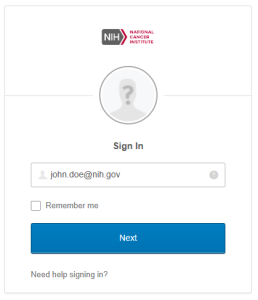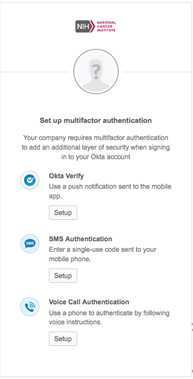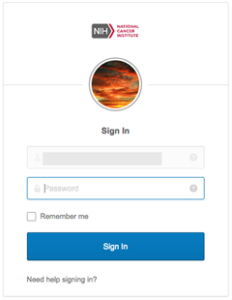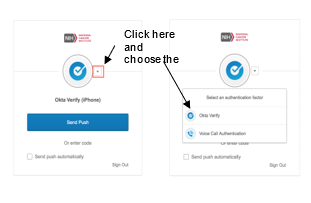 |
Page History
...
- Click on the Acknowledge and Continue button on the login screen.
- You will be taken to the Sign In screen. Please note that your username and password for CTRP STRAP remain the same.
- Enter your email address. Then click the blue “Next” button. Note: If you are a NIH user, this will send you to iTrust. Follow that authentication to gain access to CTRP STRAP.
- For non-NIH users, you will see a pop-up balloon indicating that you have not logged in with Okta before. (“This is the first time you are connecting to bioappdev.okta.com from this browser”.) Enter your password (same as previously used with Auth0/DUO) and click the blue “Sign In” button.
- The Okta “Set up multifactor authentication” window appears next. There are 3 choices, each with a ‘Setup’ button directly under the description of the method:
● Okta Verify - "Use a push notification sent to the mobile app."
● SMS Authentication - "Enter a single-use code sent to your mobile phone."
● Voice Call Authentication - "Use a phone to authenticate by following voice instructions."
- Choose the method you would like to use by clicking the ‘Setup’ button directly under your choice.
- The following sections of this document define the steps needed for each of the different methods. Please see the section that correlates to your authentication choice. Note: You may choose more than one authentication method. For example, this provides you the opportunity to connect your account with your cell phone (Okta Verify app) and your office phone (Voice Call Authentication), even if they are two different numbers. Please see the section entitled “Two Factor Option: Multiple Methods”.
- Once you have completed the setup for your chosen authentication method, click on the ‘Finish’ button.
- Next, you will see a window asking you to choose a forgot password question. Please choose a question and enter your answer. This will only be used to verify your identity prior to starting the recover password process, if necessary.
- Once you have completed the forgot password entry, you will be logged in to the application.
- The next time you click on the Acknowledge and Continue button of CTRP STRAP, you will see the initial login screen again asking for your username. Once you enter your username and click “Next”, you will see a security image above the password textbox. This security image provides extra verification that you are accessing the correct page and account. This image is randomly selected when your account is activated but should be the same each time you enter your username. (If you ever see an unfamiliar image, do not enter your password. Please contact the CTRP Engineering Support mailbox, CTRP_Support@mail.nih.gov, for assistance.
...
Clicking on this choice brings up a window that allows the user to set up their account to “Follow phone call instructions to authenticate”.
Use the dropdown picklist to choose the country of your location (United States is selected by default). The choice of country automatically populates the appropriate country code prefix for the Phone number text box.
Enter the phone number of the mobile phone that you would like to use. Fill in your extension in the “Extension” textbox, if applicable.
Next, click on the blue ‘Call’ button. (If you would like to go back and choose a different authentication method, click “Back to factor list” located in the bottom left-hand corner of the center window.)
Next, a phone call will be initiated to the phone number provided with a recorded message. Follow the instructions on the message, then hang up.
Following the authentication, CTRP STRAP will load.
The next time you log in to CTRP STRAP, a Voice Call window will appear asking to approve a phone call to the number provided (With the exception of the last 4 digits, the number will be masked).
Click to approve the phone call, then answer the phone call and follow the instructions.
Return to Step 8 in “First-Time Login Steps” to finish setup.
...
User wishes to have several methods for authentication, especially since their day-to-day schedule is extremely varied. This allows the user to choose the method that best suits their situation at login time.
Determine the configuration that best fits your situation and decide which of the authentication methods that you want to use and which phone number you want to use with each.
Follow the earlier instructions in this document for the first login. When you get to the point of choosing an authentication method, select the first method on your list. Follow the instructions in this document for that method and connect it to your chosen phone number and complete the verification.
Before logging in completely, click on “Back to factor list” in the lower left-hand corner of the window that indicates going back to the selection screen.
Choose the next authentication method on your list and follow the instructions for that method.
If you would like to choose a third method, click on “Back to factor list” in the lower left-hand corner to go back to the selection screen. When you have completed all setup configurations, you may log in to CTRP STRAP.
Return to Step 8 in “First-Time Login Steps” to finish setup. Note that if you have set up all 3 methods, you will not be routed back the “Setup multifactor authentication window”; instead you will need to set up your security question and then you will be logged in to CTRP STRAP.
Note: The next time you log into the application, one of the authentication methods will be selected by default, but you may choose another method you have set up. Click on the down-arrow icon next to the Okta symbol in the window and choose a different authentication method from the picklist.








